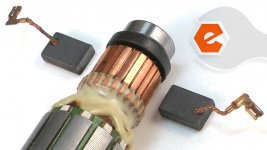The conductor material of above cable is claimed to be Linear Structured Carbon (LSC).
A quick search uncovers no information under this description.
A quick search uncovers no information under this description.
"the individual insulation also much contributes to the high sound quality: no wild electron crossings between individual conductors subject to all kinds of boundary problems. The electrons move in one direction without side movements."😀
F***ing garbage doesn't belong on this site"the individual insulation also much contributes to the high sound quality: no wild electron crossings between individual conductors subject to all kinds of boundary problems. The electrons move in one direction without side movements."😀
For some prime carbon marketing BS Carbon Nano Tube - Van den Hul B.V. - High End Cables, Phono Cartridges and Electronics
So nanotubes can be tamed for signal cables, but at 68 ohm/m its not usable for speakers. Their active cores are only microns across, though, persumably as much thicker would be even more expensive. So basically not affordable tech yet, but may become so.
Assuming they aren't making it up and using copper wire and a resistor!
F***ing garbage doesn't belong on this site
Unfortunately this site is full of this kind of garbage, or most cable threads would not exist. Weve heard from the sane, waiting for the entertainment to start.
Well, this is an ad, isn't it? Do you really expect from an ad that it doesn't praise the product to be sold in flowery words?
Best regards!
Best regards!
Does Linear Structured Carbon actually exist, perhaps under a different name?
In fairness to Van den Hul, they are one of the handful of hi-fi wire companies that do actually produce their own wire. LSC, which they don't push quite as hard as they did a few years ago, is (according to their old site) 5.5 micron carbon fibre insulated with an unspecified 0.25 micron layer. It's most often seen being used as a stranded layer surrounding metallic conductors in many of their speaker wires, interconnects &c., although the discontinued (and rather large) The Third speaker wire used it exclusively. Even with the large CSA (it was a single conductor wire so you needed 4 for a stereo pair) it wasn't the lowest resistance wire under the sun -as I recall, a 3m pair had a loop resistance of about 0.75ohm. Still, if you wanted a wire that provided some distributed series R, it would have made an effective, if pricey, way of achieving it.
Last edited:
Yes.Does Linear Structured Carbon actually exist, perhaps under a different name?
Brush it liberally on your cables and hear the difference:

Should I use a carbon brush? 😉Brush it liberally on your cables and hear the difference
Attachments
Why not?Should I use a carbon brush? 😉
Just hold the wire a couple mm away, with the motor running, and I bet you will deposit a fine layer of graphite dust on it. 😱
EDIT: just looking at the bottom of the page I see a thread called
with 208 posts 😛Cables, material and purity?
Last edited:
Aah, a nice warm controversy [emoji846]
I once had a carbon-interconnect, which was indistinguishable from copper-cables.
It‘s the xindak carbon interconnect.
( http://www.xindak.com/en-us/product_detail_info.aspx?ProductID=388 )
I once had a carbon-interconnect, which was indistinguishable from copper-cables.
It‘s the xindak carbon interconnect.
( http://www.xindak.com/en-us/product_detail_info.aspx?ProductID=388 )
I once had a carbon-interconnect, which was indistinguishable from copper-cables.
You must be a very lucky man to be able to make such a sweeping statement 😎
Your copper cables sounded all the same? They were all spot on 75ohms?
Last I checked, if it's terminated with an RCA, it'll never be 75ohms anyway. Canare have a plug that gets reasonably close; I don't know of any others off the top of my head. Or care over-much either for that matter, since it's not particularly difficult to get performance that is 'good enough' from a digital interconnect.
You must be a very lucky man to be able to make such a sweeping statement 😎
Your copper cables sounded all the same? They were all spot on 75ohms?
Nah. It‘s just that my ears, listening practice, gear, and acoustic Situation in my listening room all „overwhelm“ perceptible differences between good, very good, extremely good and plain far-out connectors.
First of all my ears ain‘t young, and then the gear is decent, but not very much more.
Why does it matter for analog interconnects?You must be a very lucky man to be able to make such a sweeping statement 😎
Your copper cables sounded all the same? They were all spot on 75ohms?
- Home
- Design & Build
- Parts
- Carbon material cables
